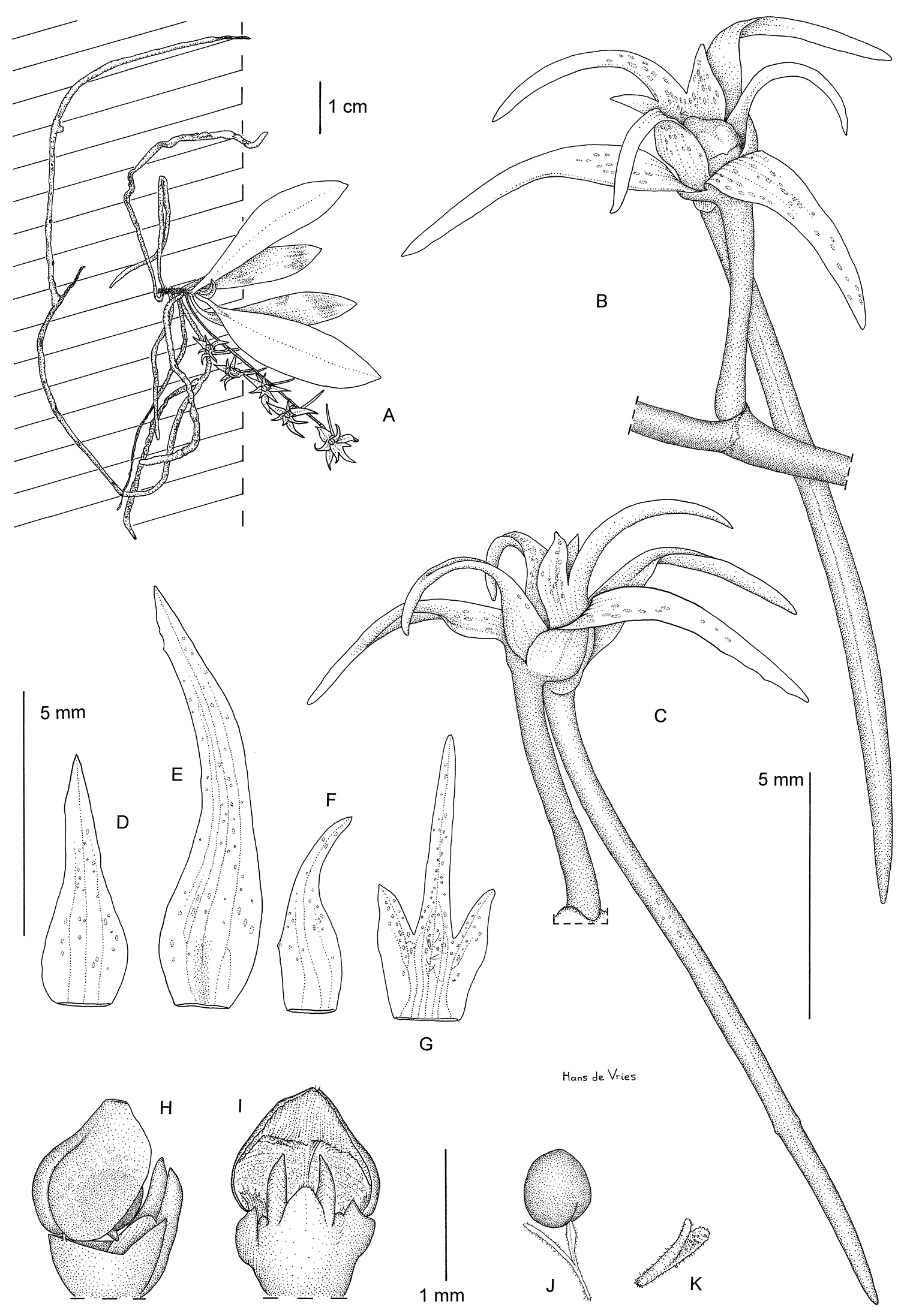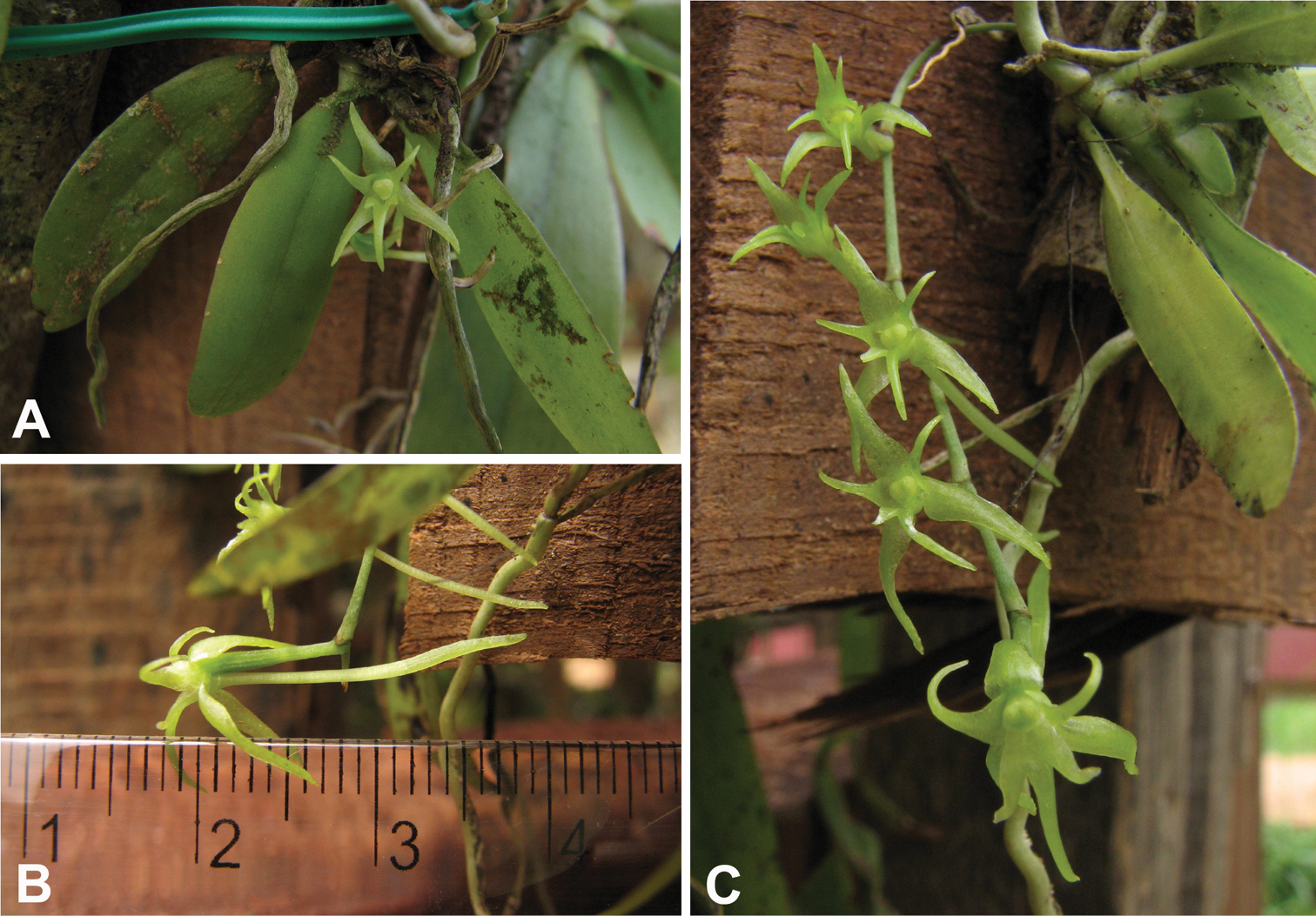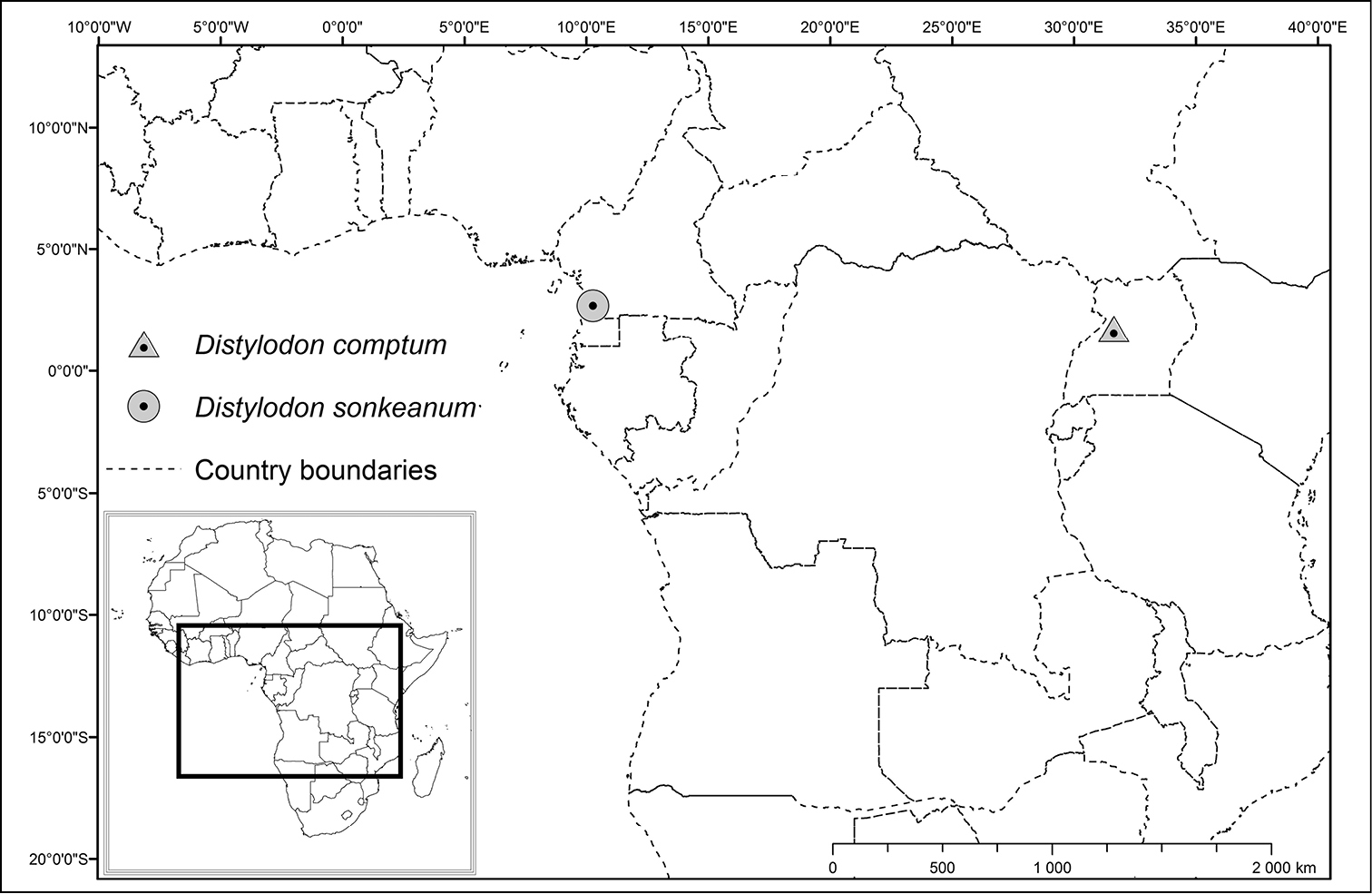






Citation: Droissart V, Cribb PJ, Simo-Droissart M, Stévart T (2014) Taxonomy of Atlantic Central African orchids 2. A second species of the rare genus Distylodon (Orchidaceae, Angraecinae) collected in Cameroon. PhytoKeys 36: 27–34. doi: 10.3897/phytokeys.36.7225
While conducting field inventories in South Cameroon, we collected two specimens of a new species that we considered to belong to the genus Angraecopsis. Afterwards, a careful examination of specimens housed at main herbaria, along with the nomenclatural types, allows us to place it in Distylodon, a monotypic genus previously known from East Africa. Distylodon sonkeanum Droissart, Stévart & P.J.Cribb, sp. nov. was collected in the lowland coastal forest of Atlantic Central Africa. It is known from a single locality in the surroundings of the Campo-Ma’an National Park. The species differs from D. comptum, by its several-flowered inflorescences, longer leaves and spur, and shorter pedicel and ovary. The species appears to be rare and is assessed as Critically Endangered [CR B2ab(iii)] according to IUCN Red List Categories and Criteria. New field investigations are required to attempt to find it in the low-elevation parts of the Campo-Ma’an National Park in Cameroon.
Angraecoid, Cameroon, Campo-Ma’an National Park, IUCN Red List Categories and Criteria, new species
During fieldwork conducted in April 2007 by the first and the third authors (
Complementary surveys in the same area and examination of closely related material preserved at BR, BRLU, K, P, WAG and YA (herbaria acronyms according to
Collections of BR, BRLU, K, P, WAG and YA were examined. Measurements, colors and other details given in the description are based on living material, alcohol-preserved specimens, and data derived from field notes. Morphological investigation used a Nikon SMZ645 stereomicroscope. The conservation status of the species was assessed by applying the IUCN Red List Categories and Criteria (
urn:lsid:ipni.org:names:77137691-1
http://species-id.net/wiki/Distylodon_sonkeanum
Figs 1, 2Distylodon sonkeanum Droissart, Stévart & P.J.Cribb, is close to Distylodon comptum Summerh. but differs from it in having several-flowered inflorescences, longer leaves and spur, and shorter pedicel and ovary.
Cameroon. Bifa (piste sur la route Kribi-Ebolowa), à 5 km au SE de Zingui, le long d’une piste de chasseurs entre les rivières Nyété et Nyamefoo, 02°41.308'N, 010°16.406'E, 5 July 2007, Droissart, Stévart & Simo M. 585 (holotype: BRLU!; isotype: YA!).
Dwarf epiphytic herb. Stem short, up to 8 mm long, 2–2.5 mm in diameter, leafy, unbranched. Roots more than 120 mm long, 1–1.8 mm in diameter, numerous, distributed at the base of the plant, unbranched. Leaves few (up to 5), 25–37 × 6–11 mm, obliquely narrowly elliptic, slightly coriaceous, with entire margins, with an indistinct and irregular reticulate venation; leaf apex obliquely subacute, unequally bilobed, with distance between the two lobes less than 1 mm. Inflorescences up to 41 mm long, 2- to 5-flowered, almost horizontal to pendant, unbranched, emerging at the base of the stem, with peduncle 13 mm long; floral internode about 6–7 mm, one flower per node; rachis terete. Bracts up to 1.2 mm long, tubular. Flowers 17–25 × 6–8 mm, not opening widely, green, the larger one situated at the apex of the inflorescence. Ovary and pedicel not twisted, 5–7 mm long. Dorsal sepal 4–7 × 1.6–1.9 mm, linear lanceolate, acute, slightly to markedly reflexed, with entire margins. Lateral sepals 5.5–9 × 1.8–2.0 mm, obliquely linear-lanceolate, acute, slightly to markedly reflexed, with entire margins. Petals 3.0–4.8 × 1.1–1.3 mm, linear lanceolate, acuminate, slightly curved forward, with entire margins. Lip 4.5–6.0 × 2.0–3.5 mm, slightly to markedly trilobed in the basal half; side lobe obliquely triangular, subacute to acute, 0.8–1.8 mm long; mid lobe much longer, 3–4 mm long, linear-subulate, acuminate, fleshy, somewhat curved forward; spur 13.5–18.0 mm long, 0.8–1.1 mm in diameter, cylindrical, straight, slightly inflated in the apical part in larger flowers, apex rounded. Column 1–1.2 × 1.0 mm, almost cylindrical with truncate apex. Rostellum 0.3 mm long, consists of two erect, subulate teeth or fangs. Anthercap 1.0 × 1.0 mm, deltoid. Pollinia two, spherical. Viscidia two, with two stipites 0.7–0.8 mm long, independent of each other, flattened, bifurcate.
Illustration of Distylodon sonkeanum (Droissart, Stévart & Simo M. 585): A habitus B flower, diagonal view C flower, side view D dorsal sepal E lateral sepal F petal G lip H column with pollinium, sideview I column with anthercap, frontal J pollinium with stipe K stipe.
Photographs of living specimen of Distylodon sonkeanum: A front view of the flower B side view of the flower C inflorescence.
Distylodon sonkeanum is endemic to the coastal part of the Lower Guinea Domain (
Distribution of Distylodon sonkeanum and Distylodon comptum in tropical Africa.
IUCN red list category: Critically Endangered, [CR B2ab(iii)]. Distylodon sonkeanum is only known from one very restricted subpopulation in Cameroon which represents one ‘location’. The main threats known to the species in the southern Cameroon are deforestation for logging and oil palm (Elaeis guineensis Jacq.) and rubber (Hevea brasiliensis (Willd. Ex A. Juss.) Müll.Arg.) plantations, resulting from a strong international demand. The ongoing loss of the forest leads us to expect a continuous decline of its habitat in the only known locality, and therefore of its extent of occurrence and area of occupancy. Moreover, this location is accessible to local residents and through their practices of shifting agriculture and small-scale timber exploitation; they are gradually transforming this area into secondary forest.
Distylodon sonkeanum appears to be rare but, due to its inconspicuous habit, further fieldwork is required to ascertain its conservation status more objectively. Considering the general habitat of Distylodon sonkeanum, it is to be hoped that more specimens and additional sites will be found in the low-elevation parts of the adjacent Campo Ma’an National Park. Based on our current knowledge of the ecology and the distribution of the species (one location and AOO less than 10 km2), and using the Criteria B of the IUCN Red List Categories and Criteria, the species was assessed as CR B2ab(iii).
The species epithet ‘sonkeanum’ refers to the Professor Bonaventure Sonké of the University of Yaoundé I, who is an internationally recognized taxonomist, specialized in the Rubiaceae’s family. He has collected extensively in the Bipindi-Akom II area, and adjacent Ngovayang massif and Campo-Ma’an National Park. He was one of the first to highlight the high biodiversity of this area and he greatly facilitated our work in Cameroon.
The genus Distylodon was established about 50 years ago by
Distylodon sonkeanum is easily distinguished from the only taxon described in the genus so far, Distylodon comptum. The new species produces pluriflorous inflorescences, longer leaves and spur, and shorter pedicel and ovary. As pointed out by
The distance between the localities of Distylodon sonkeanum and Distylodon comptum is more than 2, 000 km (Fig. 3). The Albertine Rift is well known for the concentration of many narrow endemics, being a hotspot of plant diversity in East Africa (
We express our gratitude to the curators of the following herbaria: BR, BRLU, K, P, WAG and YA for making their collections available and for the facilities offered to the authors in their institutions. We would like to thank Hans de Vries who did the drawings of the species. The American Orchid Society is gratefully acknowledged for supporting Ph.D. research of M. Simo-Droissart in Cameroon. Fieldwork, laboratory activities and herbarium visits were supported by the U.S. National Science Foundation (1051547, T. Stévart as PI, G. M. Plunkett as Co-PI).


